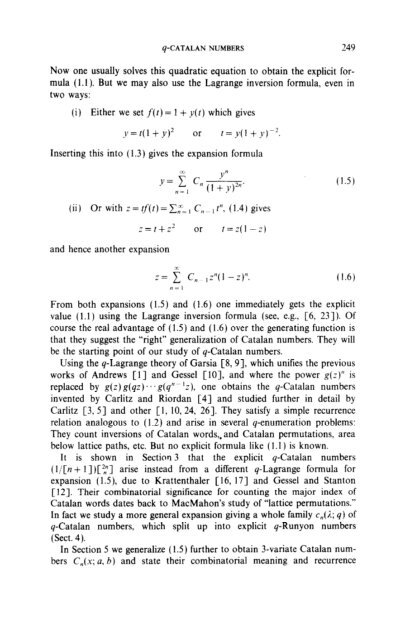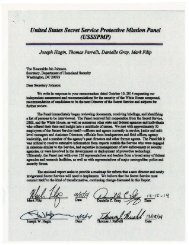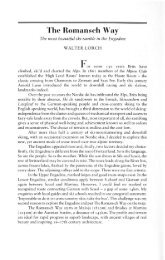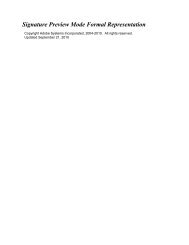85jct_catalan
You also want an ePaper? Increase the reach of your titles
YUMPU automatically turns print PDFs into web optimized ePapers that Google loves.
(I-CATALAN NUMBERS 249<br />
Now one usually solves this quadratic equation to obtain the explicit formula<br />
(1.1). But we may also use the Lagrange inversion formula, even in<br />
two ways:<br />
(i)<br />
Either we set f(t) = 1 + y(t) which gives<br />
.v=t(l+~)* or r=y(l +f’)-?<br />
Inserting this into (1.3) gives the expansion formula<br />
y=fc,, n=l (1 + y”<br />
y)'"'<br />
(ii) Or with z= tf(t)=C,“=, C+,P, (1.4) gives<br />
(1.5)<br />
and hence another expansion<br />
z=t+z” or r=z(l -z)<br />
z= f c, ,2”(1 -z)“. (1.6)<br />
n=l<br />
From both expansions (1.5) and (1.6) one immediately gets the explicit<br />
value ( 1.1) using the Lagrange inversion formula (see, e.g., [6, 231). Of<br />
course the real advantage of (1.5) and (1.6) over the generating function is<br />
that they suggest the “right” generalization of Catalan numbers. They will<br />
be the starting point of our study of q-Catalan numbers.<br />
Using the q-Lagrange theory of Garsia [S, 91, which unifies the previous<br />
works of Andrews [l] and Gessel [IO], and where the power g(z)” is<br />
replaced by g(z) g( qz) . . . g( q” ~ ‘z), one obtains the q-Catalan numbers<br />
invented by Carlitz and Riordan [4] and studied further in detail by<br />
Carlitz [3, 51 and other [ 1, 10, 24, 261. They satisfy a simple recurrence<br />
relation analogous to (1.2) and arise in several q-enumeration problems:<br />
They count inversions of Catalan words,,and Catalan permutations, area<br />
below lattice paths, etc. But no explicit formula like (1.1) is known.<br />
It is shown in Section 3 that the explicit q-Catalan numbers<br />
(l/[n + 1])[2,“] arise instead from a different q-Lagrange formula for<br />
expansion (1.5), due to Krattenthaler [ 16, 171 and Gessel and Stanton<br />
[ 121. Their combinatorial significance for counting the major index of<br />
Catalan words dates back to MacMahon’s study of “lattice permutations.”<br />
In fact we study a more general expansion giving a whole family c,(i; q) of<br />
q-Catalan numbers, which split up into explicit q-Runyon numbers<br />
(Sect. 4).<br />
In Section 5 we generalize (1.5) further to obtain 3-variate Catalan numbers<br />
C,(x; a, b) and state their combinatorial meaning and recurrence








![55721335-d6fe09eb5ffdcc87dbf6c3f0b5bbda07d2261e98[1]](https://img.yumpu.com/56533583/1/186x260/55721335-d6fe09eb5ffdcc87dbf6c3f0b5bbda07d2261e981.jpg?quality=85)








